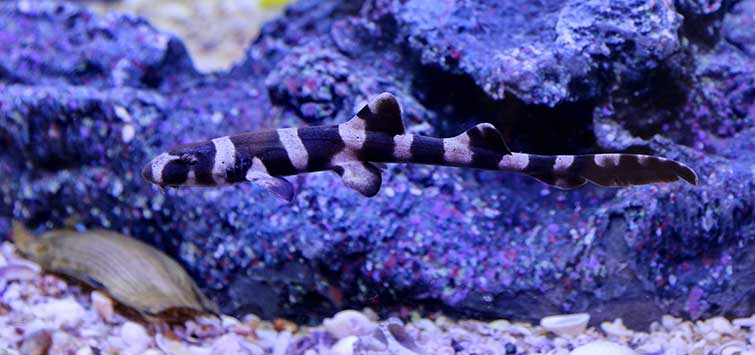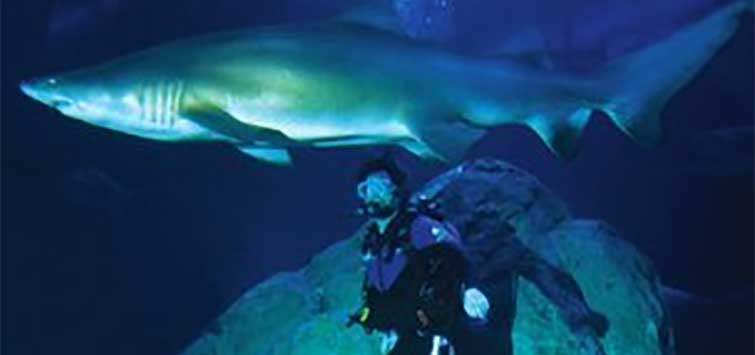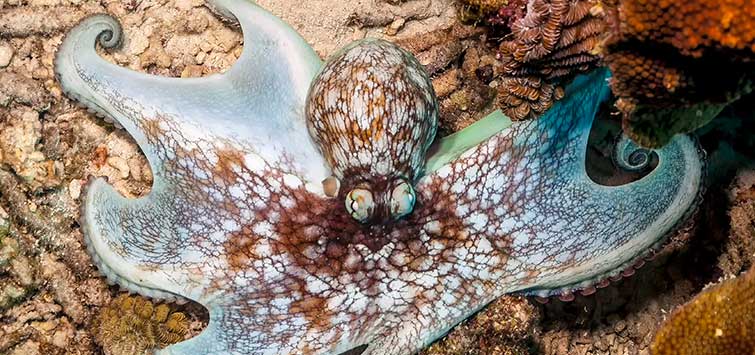So You Want to Keep a Shark
Author: Bob Goemans
Whether you’re a diver, snorkeler, or casual swimmer, the thought of having a face-to-face encounter with a shark has crossed your mind sometime in the past.
Scary Sharks
I was born and raised in the Long Island area of New York, where I spent countless hours swimming in the Amityville waters. The iconic movie Jaws—celebrating the 40th anniversary of its release this year—forever associated that area with sharks in the popular imagination. In fact, I still remember lifting my feet off the movie showroom floor during one of its more frightening scenes.
I can also remember being scared out of the water while snorkeling in the highly turbid South China Sea after a large animal brushed up against my submerged body. Just thinking “shark!” caused me to walk a quarter mile along exposed reef tops to get back to dry land.
And to be perfectly honest, sharks are not one of my favorite subjects. I’m also not overly impressed with seeing them in a home aquarium, unless the enclosure is strictly dedicated to their husbandry—and it would have to be a rather large one to accommodate that purpose.
Yet, I’m continually asked about sharks by people of all ages. I have often spent many hours trying to find answers to what, at first, seemed to be easy questions. In this article I will attempt to address these many queries and clarify some misconceptions about the mighty creatures that have fascinated and frightened us for centuries. I will also highlight some species that may be good choices for aquarists who are considering keeping them.
Shark Facts
Cartilage Framework
Animals in the Chondrichthyes class, which includes sharks, are characterized by three main features: they do not have a “bony” skeleton, but an internal framework made of cartilage; they have between five and seven gill slits; and their pectoral fins are not fused to their head.
Unique Scales
There are many unique characteristics of sharks that distinguish them from other fishes. Sharks do not have scales made up of overlapping plates. Instead, their scales are small tubercles that result in a sandpaper-like skin.
No Swim Bladder
In addition, sharks do not have a swim bladder. They must swim in order to maintain their height in the water column. Also intriguing is the fact that the front edge of their pectoral fins are sloped upward to give them lift when swimming, similar to how the wings of a plane function in the air.
Replaceable Teeth
Their teeth are not embedded in their jaw, but are arranged in rows that continually grow forward, so that the rear teeth eventually replace worn out or lost front teeth.
Range of Sizes
Sharks have no uniform average size; they come in all shapes and sizes. The smallest is the dwarf shark (Squaliolus laticaudus), which gets to about 8 inches (20 cm) in length, while the largest is the whale shark (Rhincodon typus), which reaches about 50 feet (15 m) in length.
Freshwater Sharks
Most are found in saltwater, oceans in particular. However, there are some freshwater species. Most sharks are cold-blooded, as they take on the temperature of the surrounding water. Depending upon the species, their preferred temperature ranges from the arctic to the tropical.
Shark FAQs
Are All Sharks Harmful?
This is the most common question that comes my way. In actuality, most are harmless toward people. In the rare event of an attack, it’s usually a case of mistaken identity.
Do Sharks Hear?
Sharks do not hear as we do, but they have inner ears in which a membranous labyrinth filled with fluid detects sound and pressure waves. A change in direction, or displacement in the water created by an external force, is perceived through sensory hair cells in the membrane, which then send signals to the brain. This is how sharks maintain their position and balance in the water column.
As in bony fish, sharks have a lateral line along both sides of their body that runs from the tail to the head. It detects vibrations in the water column, sometimes leading them to an injured fish (i.e., their next meal). Biologists have noted that if human beings are diving in the presence of sharks, the fish can actually detect their heartbeat underwater.
Can Sharks Smell?
When it comes to a shark’s sense of smell, the “nose knows” is my favorite way of putting it. Their nostrils (nares) have cells that detect chemicals in the water. In fact, they’re so sensitive that it’s been claimed they can detect only one part blood in one million parts water!
Do Sharks Have Eyelids?
Sharks don’t have eyelids and therefore are not able to shut their eyes. However, some have what is called a nictitating membrane that can cover and protect the eye when feeding.
Can Sharks Drown?
Sharks are capable of drowning if water does not pass over their gills, where oxygen is processed from the water. Those that continuously swim do so in a sleep-like state at times, and some bottom-dwelling sharks slip into a dormant stage while resting in the lower depths. In addition, many have suffocated in gill nets or long lines, where they can represent a large percentage of bycatch (untargeted species collected by commercial fishermen).
Hunter and Hunted
The natural life span for a shark is still based on guesswork, but some are thought to live almost 100 years, such as the spiny dogfish shark (Squalus acanthias). Though notorious for being predators, they are also hunted themselves. Barracudas, groupers, killer whales, and swordfish are counted among their natural enemies.
And let’s not forget to include human predators. Many sharks are hunted as a food, and their largest threat comes in the form of finning. In China, shark fin soup is prepared as a delicacy. They are caught, have their fins removed, and are thrown back into the sea to die. It is estimated that humans kill between 80 and 100 million sharks annually.
When it comes to what sharks eat, almost anything alive that they can get into their mouths would be a reasonable answer, including other sharks, seabirds, turtles, shrimp, clams, sea lions, dolphins, and dying whales. However, they rarely eat dead flesh unless it’s fresh (and only when necessary), and sometimes months can pass between adequate meals.
Sharks in the Hobby
When it comes to keeping sharks, the first consideration is the size of the tank. Once a shark outgrows its enclosure, there’s little to no interest—even from a public aquarium—in taking it off your hands. Releasing it back into the wild is not an option, nor should it even be considered.
Once tank size is resolved, biological filtration becomes a second factor to consider, as sharks have messy feeding habits and can produce copious amounts of waste matter. Trickle and canister filters are among the best types of equipment to maintain decent water quality. A high-quality protein skimmer would also help reduce some of this detritus before it biologically breaks down, while concurrently oxygenating the water.
Aquascaping is also a major concern, as sharks need wide open swimming areas with fine sandy bottoms to be adequately housed. Feeding strategy is another factor that deserves research, since these organisms employ different methods to find and eat their prey.
Selecting a Shark
After you’ve educated yourself about shark keeping, you’ll find that of the nine orders—Carcharhiniformes (ground sharks), Heterodontiformes (horn and bullhead sharks), Hexanchiformes (six-gilled sharks), Orectolobiformes (carpet sharks), Lamniformes (mackerel sharks), Pristiophoriformes (saw sharks), Squaliformes (spiny sharks and sogfish), Squatiniformes (angel sharks), and Rajiformes (sawfishes, skates, and rays)—only two include species that would interest marine aquarists. Those are found in the orders Orectolobiformes and Carcharhiniformes.
The order Orectolobiformes has 7 families, 14 genera, and approximately 32 species. Almost all members are bottom dwelling, mostly nocturnal, and generally harmless to people.
One of these families, Hemiscylliidae (bamboo sharks) has two genera, Chiloscyllium and Hemiscyllium, containing species that are often imported, such as the banded shark (Chiloscyllium punctatum) and the epaulette shark (Hemiscyllium ocellatum). A close third might be the Indonesian carpet shark (H. freycineti), which looks quite similar to its cousin, H. ocellatum.
The Epaulette Shark
The epaulette shark (H. ocellatum) hails from the Western Pacific, habituating in the areas of northern and western Australia (Queensland) and New Guinea. In the wild, it attains a length of about 42 inches (105 cm). In captivity, it often fails to reach this length and may be far smaller at maturity.
The epaulette shark is a nocturnal creature, dwelling on bottom reef faces, reef flats, and coral lagoons. It feeds upon shrimp, worms, and crabs by digging them out of the sandy bottom areas. This species requires a 200-gallon (757-liter) aquarium minimum, and it should be fed three times a week with fresh seafood. Shrimp, fish flesh, crab, octopus, cuttlefish, urchins, squid, krill, and scallops are all appropriate foods for this shark. Small live marine fish would also make a good occasional dinner treat.
Substrate
The aquarium housing should have a fine sandy bottom and provide large caves and/or ledges to hide under. Because this species digs to find its food, any large rock caves or ledges should be securely formed to prevent cave-ins.
Filtration
A well-filtered and well-oxygenated system with few environmental obstructions is also necessary. Keep in mind that most sharks cannot be treated with heavy metal solutions, such as copper.
Tankmates
Do not house the epaulette shark with large triggerfish, angelfish, wrasses, or pufferfish, as they can pick on the shark and cause skin and/or eye damage. Even though this is probably the best shark species for home aquariums, it is not a petting animal and will bite if provoked.
Carpet and Bamboo Sharks
The Indonesian carpet shark (H. freycineti), which resembles the epaulette, also hails from the Western Pacific (Indonesia and Papua New Guinea) and reaches a length of about 28 inches (70 cm). The difference between them, depending on age, can sometimes be distinguished by the coloring around the eye. H. ocellatum’s eye is ringed with white, while H. freycineti’s is not. Otherwise, the same husbandry conditions apply.
Staying in this family, there are two bamboo sharks—the whitespotted bamboo shark (C. plagiosum) and the brownbanded bamboo shark (C. punctatum)—that are also good choices for the home aquarium. The whitespotted bamboo shark hails from the Indo-West Pacific Ocean. It attains a length of about 37 inches (95 cm) in the wild, inhabits inshore coral reefs, and is usually found in crevices and caves.
The brownbanded bamboo shark reaches a length of about 40 inches (100 cm) and inhabits the waters stretching from Japan to northern Australia. The same husbandry conditions as mentioned above also apply to these two species, as their behavior and needs are the same. In fact, captive-bred specimens are available, as are their eggs.
Catsharks and Wobbegongs
There are several catsharks in the order Carcharhiniformes, family Scyliorhinidae, that are worth considering because their smaller size reduces the required aquarium size needed for their upkeep. One of these is the coral catshark (Atelomycterus marmoratus), which hails from the Indo-West Pacific and only attains a length of about 27 inches (65 cm).
Catshark Coloration
Color patterns vary depending upon where the species originates from. The coral catshark is another nocturnal, shallow water species that feeds upon benthic invertebrates and small fish. Again, their husbandry is the same as previously mentioned.
Wobbegongs
There’s one other shark that seems to interest some aquarists who can afford very large tanks, and those are the wobbegongs in the family Orectolobidae, order Orectolobiformes. These odd-looking sharks have a flattened body, a very broad head with long barbells, and flaps of skin around the mouth.
They range in size from 3 to 10 feet (1 to 3 m). These nocturnal sharks feed upon octopus, squid, other sharks, crabs, shrimp, rays, fish, and just about anything else they can ambush. Some species, such as Eucrossorhinus dasypogon, would require a 1000-gallon (3785-liter) aquarium!
Even though the wobbegong’s appearance is quite fascinating, it’s another inactive species during daylight hours, so the visual enjoyment that one usually associates with keeping fish is going to be left unfulfilled.

.png?h=595&iar=0&w=2781&hash=5FD5E69473BCC22199FBFA2FB71B6033)



